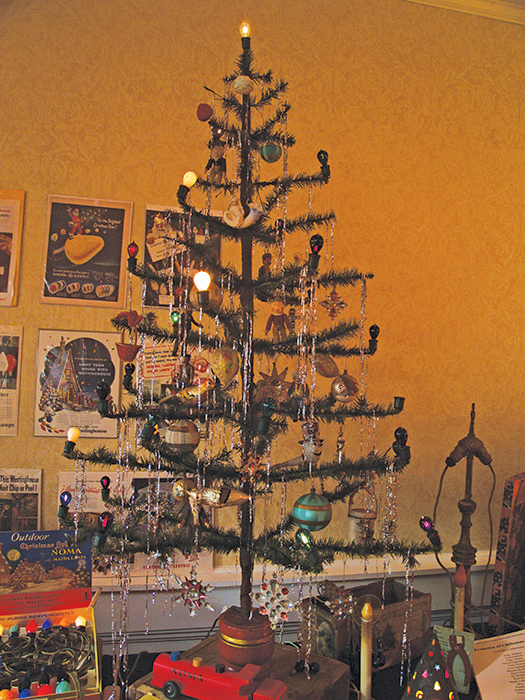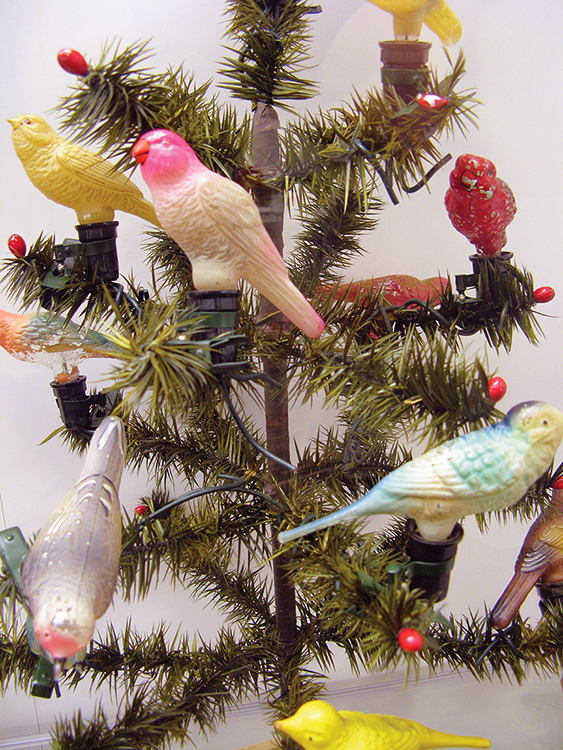
I and other collectors consider the Golden age of Christmas lighting to be from 1900-1950’s. Not so much before WWII but definitely following the War electric Christmas lighting blossomed. The focus was just not on the indoor tree and indoor decorations but a new focus on outdoor lighting blossomed. Homes were outlined, outdoor shrubbery was lighted and outdoor plastic lawn decorations such as Santa’s, Snow Men, Choir Boys and Girls, Angels, Nativities and so on became popular.
The first electric lighted Christmas tree dates back to 1882. An associate of Thomas Edison, Edward Johnson, is credited to have first lighted a Christmas tree. He wired together little lamps in red, white and blue and strung them on a tree that had a rotating stand. This was quite a fascination for those passing by the window of the factory. Remember at this time there were no light strings or even light sockets for these little lamps. Each bulb had a wire coming out of either end and they had to be linked together for a flow of electricity and to illuminate the lamps. If someone wanted to light their tree at home, an electrician was required to make all of the necessary connections, a long, tiresome and expensive endeavor. These early bulbs were blown glass globes with carbon filaments. They were blown of colored glass and later painted on the outside. These were found to burn very hot and their was a safety concern for fires.
By the late teens, tungsten was the choice element for the filament, cooler burning and safer. Building upon the round or pear shaped lamps, lamps were also made into numerous lighted holiday shapes resembling the figural Christmas ornaments of previous years. There were Santas, angels, fruits, flowers, snowmen, clowns and popular comic characters to mention a few. In the beginning, molds from ornaments were the first shapes made into bulbs. These figural bulbs were made in several countries. Austria, Germany, Hungary, Japan and the United States.

The bulb makers changed to milk glass bulbs in the 1920’s because it was found, with the paint stayed on the milk glass, the cracking of the paint with the expansion from the heat was lessened with the milk glass bulb. Figural lamps remained popular through the 1950’s.

Morris Propp of NY was one of the earliest light set manufacturers along with Ever Ready. With the incorporation of NOMA (National Outfit Manufacturers Association) in 1928 several smaller companies now made up the new NOMA corporation and Morris Propp became the President and CEO. Collectors will discover that in these early years parts typical of Propp sets will be incorporated intoNOMA sets due to this consolidation. TheNOMA corporation could now boast of safety and UL approval of their lighting sets. From 1928 through the mid 1950’sNOMA became a household word for quality Christmas lighting. Other notable companies of this time were Raylite of NY and Royal of Pawtuckett, RI.
General Electric Co. became the number one manufacturer of Christmas lamps along with Westinghouse and Sylvania. GE lamps are marked with GE Mazda (early), GE either in block letters or script (later), Westinghouse lamps are marked with a W and Sylvania lamps with an S. There were 2 minor players in the bulb industry that I would like to include, Nilco (Novelty Incandescent Lighting Co) who only produced one C9 light set between 1924 and 1928 and their lamps are marked with an N. USAlite (United States Electric) produced miniature base C6 lamps in the 1950 marked USA.
